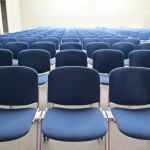Transition
by Fr. John Whiteford
 As my doubts about Protestantism increased, I found myself in a very unpleasant situation. As an associate pastor, I had certain responsibilities, which included leading a small group on Sunday nights, and also occasionally preaching on Sunday morning. I continued to fulfill these duties, but was increasingly less convinced about the things that I was expected to teach and preach.
As my doubts about Protestantism increased, I found myself in a very unpleasant situation. As an associate pastor, I had certain responsibilities, which included leading a small group on Sunday nights, and also occasionally preaching on Sunday morning. I continued to fulfill these duties, but was increasingly less convinced about the things that I was expected to teach and preach.
I also began attending Saturday night vespers at St. Benedict on a regular basis, and then on Sunday morning, I was back at the semi-charismatic Nazarene Church of which I was the associate pastor. The contrast between these two very different styles of worship on a weekly basis had the effect of increasingly convincing me of the shallowness of Protestant worship in general, but especially the “contemporary” style of worship that my Nazarene Church was using. There were two “worship songs” that stood out as being especially shallow. One was
“As David did in Jehovah’s sight, I will dance with all my might”
– which had no meaning other than that we were going to jam to the tunes of the rock band that was playing the music. Another was “Blow the Trumpet in Zion,” which was based on words from Joel, chapter 2. However, this song twisted the meaning of the words in that prophecy to suggest that it was talking about what a powerful army the people of God were, when it fact the prophecy is a prophecy of judgment on the people of God who have sinned. The army that is talked about in that passage, that is about to “run on the city” and “run on the walls” is an army that is coming to destroy Zion (Jerusalem) at God’s command. The trumpet is blown in Zion to sound the alarm, because Jerusalem is under attack. God is calling His people to repent, if they wish to avoid this judgment… but this “contemporary worship” song is anything but a penitential song. One Sunday, when I was asked to preach, I preached on Joel 2, and explained why this song distorted the meaning of the passage, and what it actually meant.
Next Sunday, the “worship team” sang it again, as usual.
The Sonlight Center had met with moderate success in building up a congregation, but it was initially underwritten by the District (which is similar to a Diocese), and had a very expensive lease on a very nice and large storefront facility, but the district only promised to provide financial backing for a period of about a year, and the day came when that support ended. I was not much involved in the business side of that Church, but a decision was made that we needed to look for a new and more affordable location. While we were in transition, our services were for a time held at a Messianic Jewish Church, which obviously would not have services on Sunday, since it had its services on Saturday. But since they were hosting us, I attended some of their services. Their services bore almost no resemblance to a traditional Jewish Synagogue service. Essentially, their worship was typical Charismatic worship, with some cheesy Jewish stuff thrown in, and a lot of Fiddler-on-the-Roof style music. I found that the people in the Church were almost all Southern Baptist Okies that were looking for something that had tradition. I thought it was unfortunate that instead of looking into Christian Tradition, they had gone down the path of Judaizing Christianity.
This was just further evidence of the collapse of Evangelicalism, which has only accelerated in the years since.

Leave a Reply